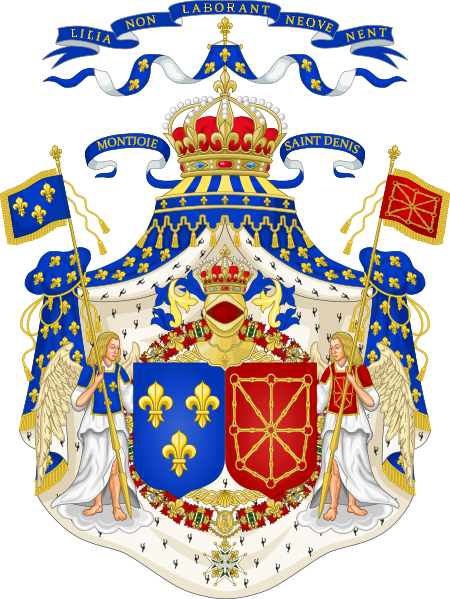File:Grand Royal Coat of Arms of France & Navarre.svg

Size of this PNG preview of this SVG file: 450 × 599 pixels. Wasu yarjejeniyoyi: 180 × 240 pixels | 360 × 480 pixels | 576 × 768 pixels | 769 × 1,024 pixels | 1,537 × 2,048 pixels | 1,190 × 1,585 pixels.
Hoton asali (Fayil kin SVG, saƙar fikisal 1,190 x 1,585, girman fayil: 5.96 MB)
Tarihin fayil
Ku latsa rana/lokaci ku ga fayil yadda yake a wannan lokaci
| Rana/Lokaci | Wadar sufa | Kusurwowi | Ma'aikaci | Bahasi | |
|---|---|---|---|---|---|
| na yanzu | 10:15, 28 Nuwamba, 2023 |  | 1,190 × 1,585 (5.96 MB) | Louis de Lauban | Reverted to version as of 00:16, 9 February 2023 (UTC) |
| 14:23, 25 Nuwamba, 2023 |  | 512 × 663 (2.74 MB) | Håland10 | Reverted to version as of 10:41, 25 November 2023 (UTC) | |
| 14:22, 25 Nuwamba, 2023 |  | 1,190 × 1,585 (5.96 MB) | Håland10 | Reverted to version as of 00:16, 9 February 2023 (UTC) | |
| 10:41, 25 Nuwamba, 2023 |  | 512 × 663 (2.74 MB) | Håland10 | Reverted to version as of 10:25, 1 October 2022 (UTC) | |
| 00:16, 9 ga Faburairu, 2023 |  | 1,190 × 1,585 (5.96 MB) | Louis de Lauban | fixed error in motto script | |
| 23:47, 8 ga Faburairu, 2023 |  | 1,190 × 1,585 (6.07 MB) | Louis de Lauban | Second motto added as mentionned in textuals sources / accurate crown as depicted in visuals sources | |
| 10:25, 1 Oktoba 2022 |  | 512 × 663 (2.74 MB) | Sodacan | cleanup | |
| 06:18, 29 Oktoba 2019 |  | 1,190 × 1,542 (3.37 MB) | Sodacan | minor fixes | |
| 08:08, 29 Nuwamba, 2009 |  | 1,190 × 1,542 (7.28 MB) | Sodacan | fixed helm | |
| 20:05, 25 Nuwamba, 2009 |  | 1,190 × 1,542 (7.28 MB) | Sodacan | correct mistake |
Amfani da fayil
Wadannan shafi na amfani wannan fayil:
Amfanin fayil a ko'ina
Wadannan sauran wikis suna amfani da fayil din anan
- Amfani a kan af.wikipedia.org
- Amfani a kan an.wikipedia.org
- Amfani a kan ar.wikipedia.org
- بوابة:الإمبراطورية الروسية
- بوابة:الإمبراطورية الروسية/بوابات شقيقة
- شعار فرنسا
- شعار هايتي
- آل بوربون
- مملكة فرنسا (1791–92)
- بوابة:الإمبراطورية الألمانية
- بوابة:الإمبراطورية الألمانية/بوابات شقيقة
- بوابة:إمبراطورية اليابان
- بوابة:إمبراطورية اليابان/بوابات شقيقة
- بوابة:الخلافة الراشدة
- بوابة:الدولة الأموية
- بوابة:الإمبراطورية الفرنسية الأولى/بوابات شقيقة
- بوابة:الإمبراطورية الفرنسية الأولى
- بوابة:الإمبراطورية النمساوية/بوابات شقيقة
- بوابة:الإمبراطورية النمساوية
- قائمة ملوك فرنسا
- بوابة:الإمبراطورية البريطانية
- بوابة:الإمبراطورية البريطانية/بوابات شقيقة
- بوابة:الإمبراطورية الفرنسية الثانية
- بوابة:الإمبراطورية الفرنسية الثانية/بوابات شقيقة
- بوابة:الإمبراطورية البرتغالية
- بوابة:الإمبراطورية البرتغالية/بوابات شقيقة
- بوابة:الإمبراطورية النمساوية المجرية
- بوابة:الإمبراطورية النمساوية المجرية/بوابات شقيقة
- بوابة:الإمبراطورية المغولية
- بوابة:الإمبراطورية المغولية/بوابات شقيقة
- بوابة:الإمبراطورية الإسبانية
- بوابة:إمبراطوريات
- بوابة:إمبراطوريات/بوابات شقيقة
- بوابة:الإمبراطورية الإسبانية/بوابات شقيقة
- بوابة:الدولة الأموية/بوابات شقيقة
- بوابة:الخلافة الراشدة/بوابات شقيقة
- مملكة فرنسا
- بوابة:مملكة فرنسا
- بوابة:مملكة فرنسا/أعلام وشعارات
- بوابة:مملكة فرنسا/بوابات شقيقة
- بوابة:الإمبراطورية الرومانية المقدسة
- بوابة:الإمبراطورية الرومانية المقدسة/بوابات شقيقة
- قالب:بوابات الإمبراطوريات
- الحقبة الحديثة المبكرة لفرنسا
- سانتو دومينغو (مستعمرة فرنسية)
- Amfani a kan arz.wikipedia.org
Duba ƙarin amfanin wannan fayil.








